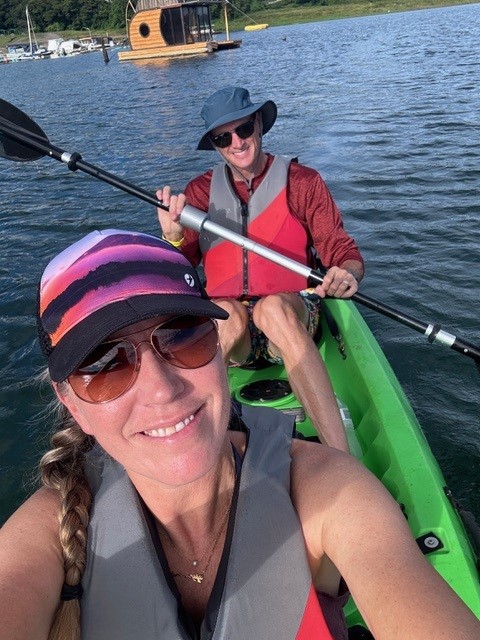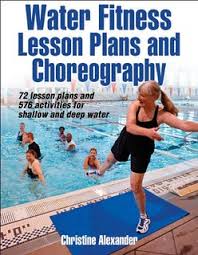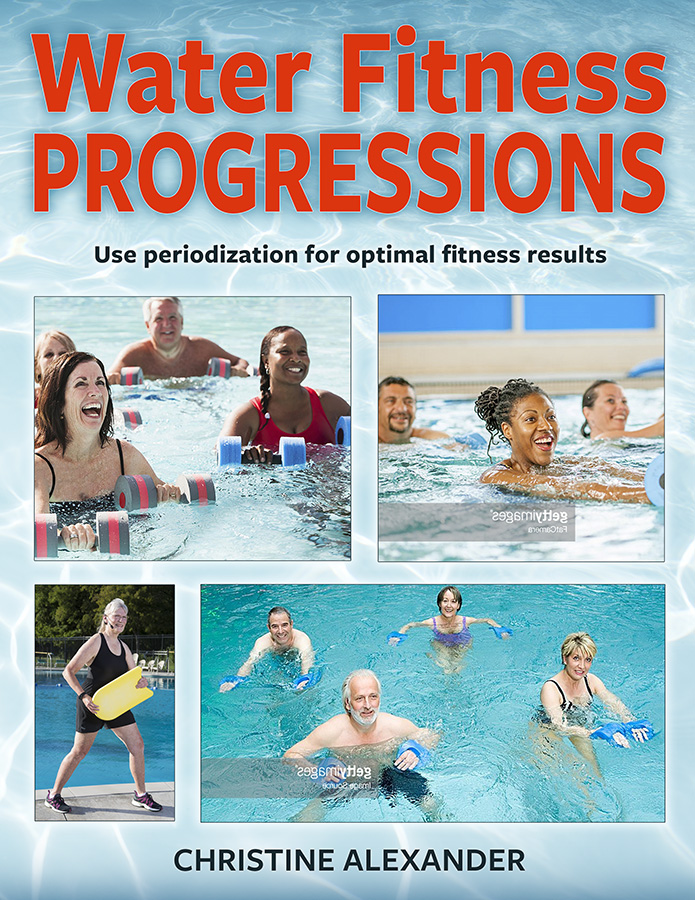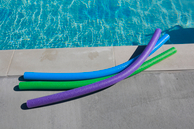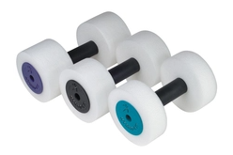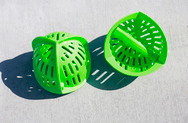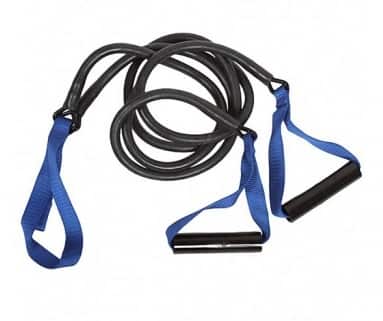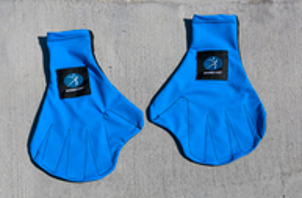
Some people believe they work harder in a deep-water class if they don’t wear a belt. Well, they might work harder trying to tread water, but what does their posture look like? They either lean forward, or their legs drift toward the surface of the water, trying to create a larger surface area that assists flotation. All exercise is properly performed with good postural alignment, that is, with the head over the shoulders, the shoulders over the hips and the feet under the body. In good alignment without a deep-water belt, you sink. What about using a set of foam dumbbells in the hands to assist with flotation? If you do that, you are hanging your body weight from your shoulders which is not a good idea because the shoulder joint is not a weight bearing joint. You are also causing impingement to your rotator cuff and repeated impingement can cause a rotator cuff tear. (See my blog post on the shoulders.) You could try straddling a noodle. That limits the number of exercises you are able to do, and for me, having to repeatedly adjust the noodle is a distraction. Wearing a deep-water belt allows me to perform multiple exercises, in different positions, in good alignment, with no stress on my shoulder joint, while increasing and decreasing intensity at will. I can safely add any piece of equipment I choose because I am supported by my belt and not hanging from the equipment.
The best deep-water belt is one that feels comfortable for you and allows you to maintain good postural alignment. There are a wide variety of belts to choose from. Here are some of the options:

Hydro-Fit Classic Wave Belt. $59.95 in sizes S, M, L, and XL. Hydro-Fit was founded by Craig Stuart in 1987. You can’t go wrong with Hydro-Fit equipment. The belt is made of soft and durable EVA foam that forms to the natural shape of your body. It really is durable! I’ve had mine for years. If the strap or buckle wears out, you can get a replacement strap. (My strap hasn’t worn out yet.) There is a sizing chart on the website to help you choose the correct size. I like that it has even buoyancy around my waist so that I feel balanced in the water. Hydro-Fit also has an easy close Wave belt with a Velcro closure for those who have difficulty with the buckle. And they have a Wave belt pro with less buoyancy for a more challenging workout.

Aquajogger Classic Belt. $59.95. Aquajogger was founded in 1987. The company says that the contour design tones the abdominal muscles while strengthening the lower back. The extra buoyancy in back tends to pitch me forward a little bit, but is good for those whose bodies have extra buoyancy in front. The belt comes with a 48-inch elastic strap. The strap tends to stretch out over time, but replacement straps are available. Instead of sizes, Aquajogger belts come in 8 different shapes ranging from least buoyant to most buoyant, and ranging in price from $49.95 to $69.95.

Water Runner Flotation Belt. $45.99. This belt is made by Water Gear which has been in business since 1994. It is made of soft, comfortable, closed cell EVA foam, which does not chip, break or absorb water. The strap is made of nylon, and replacement straps are available. The belt comes in size X-SM (under 100 lbs.), S (100-160 lbs.), MED (160-220 lbs.), and LG (220+ lbs.). The patented design is said to float the individual in the proper vertical position, relieving stress on the lower back. I find the wings on the side to be uncomfortable, but some people like them.

Speedo Aqua Fitness Jogbelt. $38.00. Speedo is an Australian company that has been around for over 100 years. They sell everything from swimsuits to goggles. Their deep water belt comes in size S-M which adjusts to waist sizes 25-48 inches, and size L-XL which adjusts to waist sizes 25-56 inches. That means that the foam part is one size and it is the strap that adjusts the fit. That may make the curving of the foam belt uncomfortable for some. The belt is made of soft chlorine resistant foam and it has a 6-month warranty against deficiencies in manufacturing. It is more affordable than some of the other deep-water belts, but it does not last as long.

Aqua Fitness Deluxe Flotation Belt. $27.99. This belt is made by Aqua-Leisure, a company founded in 1970. The belt is currently out of stock on their website, but you can find it on Amazon.com for $25.87. It is made out of EVA foam with a fabric cover that is designed to be soft on skin for less irritation. The strap adjusts to fit a 20-60 inch waist, which means it is one size fits all. Its slim design may not provide enough buoyancy for some adults. The brand recommends that the belt not be exposed to harsh sunlight for too long, but that is not a problem in an indoor pool.

TYR Aquatic Flotation Belt. $37.43. TYR was founded in 1985. The blocks are made out of EVA foam, and the strap has an adjustable belt and clip system. The belt fits waist sizes 27-52 inches. You can slide the blocks around the strap so that you can have 2 blocks in the back, one on each side, and 2 in the front. Or have them all in back, or any other adjustment that works for you. The blocks are narrow and some people might need more than six to get enough flotation.

Water Gear also makes a block belt for $27.99. The blocks are made of closed cell EVA foam. The Water Gear blocks are larger than the TYR blocks which makes this belt a little more buoyant. Blocks can be removed to adjust the buoyancy for those who have a smaller waist or prefer less buoyancy. The strap is 2 inches wide and 60 inches long, with an adjustable buckle. Replacement straps are available.

Wet Vest. For those who are serious about sports conditioning, cross training or aquatic therapy, Hydro-Fit makes the Wet Vest for $244.95. Its patented design incorporates flotation panels sewn into a comfortable and snug fitting body vest. Like a wet suit, it provides a thermal layer that insulates your body in the water. The wet vest works great for people who are uncomfortable wearing a belt around the waist due to injury or other medical issues, which is why it is often used by aquatic therapists. The Wet Vest allows maximum freedom of movement. It comes in blue or black, in sizes small, medium, large, X large and XX large.

Fitness Buoy. Buoy Products sells the Fitness Buoy for $59.95. Buoy Products is a relatively new company, founded in 2017, and their Fitness Buoy is a new concept in flotation devices. They also make a Body Buoy which is similar to the Fitness Buoy, but in grey and 5 other bright colors. The price of the Body Buoy is the same as the Fitness Buoy. They comes in sizes small, medium, large and X large. The equipment is designed to be worn like shorts and fasten around the waist and legs. They advertise that you can comfortably do full range of motion movements in deep water without your device digging into your ribs or riding up to your armpits.
There are other deep water belts out there. Let me know if you have a favorite that I did not mention, or if you are a fan of one of the pieces of equipment in this post. Whatever you do, put one on before you take your deep-water class. See you in the pool!





